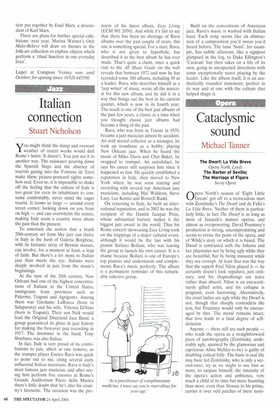Italian connection
Stuart Nicholson
Njou might think the damp and overcast weather of recent weeks would dull Rome's lustre. It doesn't. You just see it in another way. The rainwater pouring down the Spanish Steps and the absence of tourists gazing into the Fontana de Trevi make these picture-postcard sights somehow real. Even so, it is impossible to shake off the feeling that the culture of Italy is too great for even its inhabitants to consume comfortably, never mind the eager tourist. It looms so large — around every street corner, looking down on you from on high — and can overwhelm the senses, making Italy seem a country more about the past than the present.
To entertain the notion that a brash 20th-century art form like jazz can thrive in Italy in the hush of Galeria Borghese, with its fantastic array of Bemini statues, can involve, for a moment at least, a leap of faith. But there's a lot more to Italian jazz than meets the eye. Italians were deeply involved in jazz from the music's beginnings.
At the turn of the 20th century, New Orleans had one of the highest concentrations of Italians in the United States, immigrants from provinces such as Palermo, Trapani and Agrigento. Among them was Girolamo LaRocca (born in Salaparuta) and his wife, Vittoria DiNino (born in Trapani). Their son Nick would lead the Original Dixieland Jazz Band, a group guaranteed its place in jazz history for making the first-ever jazz recording in 1917. The drummer in the band, Tony Sbarbaro, was also Italian.
In fact, Italy is very proud of its contributions to jazz, albeit at one remove, as the trumpet player Enrico Rava was quick to point out to me, citing several early influential Italian musicians. Rava is Italy's most famous jazz musician, and after seeing him perform five encores at Rome's Grande Auditorium Parco della Musica there's little doubt that he's also his countty's favourite. The occasion was the pre
miere of his latest album, Easy Living (ECM 981 2050). And while it's fair to say that there has been no shortage of Rava albums over the past couple of years, this one is something special. For a start, Rava, who is not given to hyperbole, has described it as the best album he has ever made. That's quite a claim, since a quick visit to the All Music Guide on the web reveals that between 1972 and now he has recorded some 100 albums, including 30 as a leader. Rava, who describes himself as a 'lazy writer' of music, wrote all the material for this new album, and he did it in a way that brings out the best in his current quintet, which is now in its fourth year. The result is one of the best jazz albums of the past few years, a classic at a time when you thought classic jazz albums had become a thing of the past.
Rava, who was born in Trieste in 1939, became a jazz musician almost by accident. An avid record collector as a teenager, he took up trombone as a hobby, playing New Orleans jazz. When he heard the music of Miles Davis and Chet Baker, he swapped to trumpet. An autodidact, he says his career still surprises him since it happened so fast. He quickly established a reputation in Italy, then moved to New York where he was soon touring and recording with several top American jazz musicians, including Mal Waldron, Steve Lacy, Lee Konitz and Roswell Rudd.
On returning to Italy, he built an international reputation, and in 2002 he was the recipient of the Danish Jazzpar Prize, whose substantial bursary makes it the biggest jazz award in the world. Thus his Rome concert showcasing Easy Living took on the trappings of a major cultural event, although it would be the last with his pianist Stefano Bollani, who was leaving the group to launch his own career. It is a shame because Bollani is one of Europe's top pianists and understands and complements Rava's music perfectly. The album is a permanent reminder of this remarkably cohesive group. Built on the conventions of American jazz, Rava's music is washed with Italian hues. Each song seems like an abstraction of a composition you'd swear you'd heard before. The tune 'Sand', for example, has subtle allusions, like a signpost glimpsed in the fog, to Duke Ellington's 'Caravan' but then takes on a life of its own, going in unexpected directions with some exceptionally suave playing by the leader. Like the album itself, it is an aesthetically rounded statement, perfect in its way and at one with the culture that helped shape it.


















































































 Previous page
Previous page